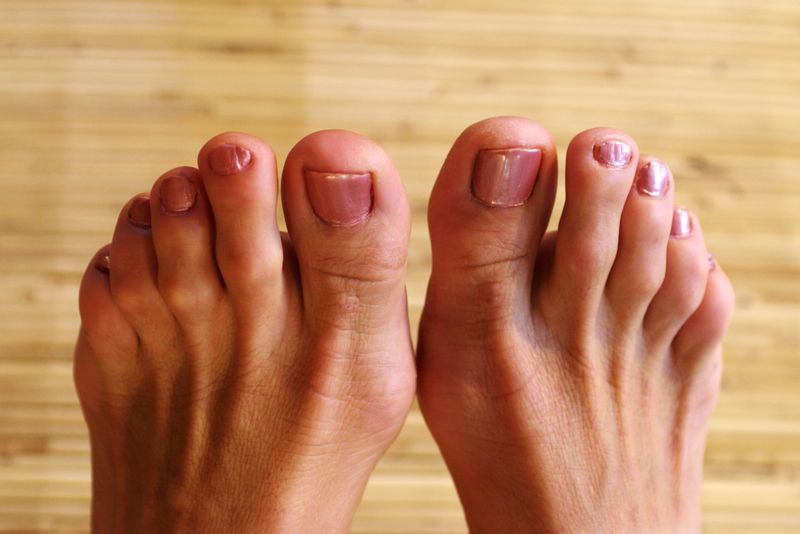Hammertoes! How to treat based on type

Contracted digits. Often a concern during sandal season, digit contractures are much more than a cosmetic issue. Our toe alignment and strength play an important role in balance, push off, acceleration and jumping.
When our toes start to contract we lose ground contact and stability through our feet. From a lever perspective, the longer and straighter that our toes are, the greater the amount of power we can release.
This means, to optimize our foot function and movement, we ideally want straight digits.
Toes not staying straight?
You may be experiencing some type of toe contracture.
This article will go into the most common types of toe contractures, as well as best practices to treat based on type.

Hammer, Mallet, Claw – Oh my!
There are three main types of toe contractures based off of which joint in the toe is contracting.
If only the first joint of the toe (the one closest to the foot) is contracting this is referred to as a hammertoe. This is the most common type of toe contracture seen by a podiatrist.
If only the 2nd joint of the toe (the one closest to the nail) is contracting this is referred to as a mallet toe. This is often seen in those with a long 2nd digit also known as a Morton’s toe.
If both joints of the toe are contracting, then this is called a claw toe. Both a mallet toe and claw toe can cause calluses to form on the tip of the toe or thickening of the toenail due to microtrauma.
Flexible vs. Rigid Contractures
Once you determine the type of toe contracture you have, the next step is to determine if it is a flexible or rigid deformity. Start by grabbing your toe and try to straighten the contracture.
Does the toe pull straight but as soon as you let go it contracts in again? If so, this is considered a flexible deformity and one that can potentially be reversed.
If you try to pull the toe straight and it does not move, then this is considered a rigid contracture. This is a progression of toe contractures that involves arthritis, making it a structural deformity. Unfortunately, the only way to make rigid contracture straight is surgery.
Extensor vs. Flexor Dominant
There is one last classification of toe contractures we need to go through in order to accurately treat our feet. This last one has to do with which muscles are dominant and contributing to the contractures in the first place.
To determine which type you have start by standing on both feet. Push your toes down into the ground like when you perform short foot exercise. Do you notice your toes contracting?
Relax your toes and now do a heel raise. Do you notice your toes contracting?
If you answered yes to either or both of these, then you have a flexor dominant contracture. This means that the flexor digitorum longus is over-powering the small intrinsic toe muscles.
To determine if you have an extensor dominance, stand on both feet again but this time do a squat. As you squat down, do you notice your toes contracture or even lifting off of the ground?
Relax your feet and now start to slowly march in place. Look at your toes. Every time you pick up your foot, do your toes lift and contract?
If you answered yes to either of the last 2 tests, then this is an extensor dominance. This means your extensor digitorum longus is over-powering your small toe intrinsics.
Treat by Type
The most effective digit contracture treatment is based off of which type of deformity you have. Below are simple guidelines you may use to start to create balance in your toes.
Remember the most important thing is whatever you do, be consistent. If you are still not sure which type of contractors you have then see your podiatrist for a functional foot evaluation.
Type 1 – Flexible Flexor Dominant Contractures
Release the muscles in the back of the leg with the Neuro Ball
Release the muscles in the bottom of the foot with the Neuro Ball
Wear the Naboso Splay toe spacers as much as possible including in your shoes
Activate and connect to foot intrinsics with short foot exercise
Type 2 – Flexible Extensor Dominant Contractures
Release the muscles in the back of the leg with the Neuro Ball
Release the muscles in the bottom of the foot with the Neuro Ball
Wear the Naboso Splay toe spacers as much as possible including in your shoes
Activate and connect to foot intrinsics with short foot exercise
Type 3 – Rigid Hammer or Claw Toes
Wear the Naboso Splay toe spacers as much as possible including in your shoes
Release the muscles in the bottom of the foot with the Neuro Ball
Activate and connect to foot intrinsics with short foot exercise